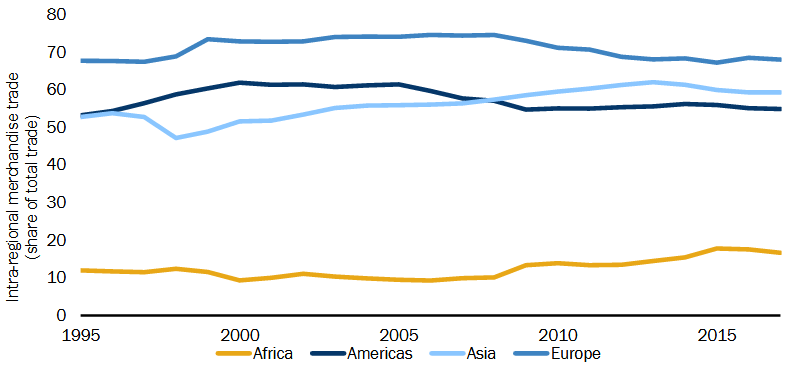

In terms of its integration with COMESA, 63 per cent of imports by the Sudan from the bloc were intermediate or capital goods, which places it eighth on this measure out of the 19 COMESA members for which data were available. Thus, in 2013, 68 per cent of its imports from CEN-SAD were intermediate and capital goods, placing the country twelfth out of the 19 countries for which this measure was available. Although trade between the Sudan and other members of the same regional economic community is relatively low, the proportion of intermediate and capital goods is not so low.

The index also measures productive integration, looking at intra-regional trade in intermediate goods. It scored moderately (twenty-fifth out of all countries in Africa) on the UNCTAD merchandise trade complementarity index in 2012, which measures the extent to which a country’s trade is complementary with that of its partners. Productive integration: The Sudan’s performance in terms of its integration into regional value chains within the regional economic communities of which it is a member can be improved.

This may be due to its import integration and relatively low tariffs on imports from other African countries, and also to the fact that it performs relatively well when compared with members of the other communities of which it is a member (CEN-SAD, COMESA and IGAD). In spite of these seemingly low values for intra-African trade, the Sudan is among the highest ranking countries in terms of its overall trade integration with the regional economic communities of which it is a member. 0.4 per cent of its GDP is accounted for by exports to IGAD, meaning that within IGAD, it ranks third from last on this measure among the member countries. 0.4 per cent of the GDP of the Sudan was accounted for by exports to COMESA in 2013. Only 0.1 per cent of its GDP was exported to CEN-SAD in 2013, placing the country 22nd among the 23 CEN-SAD members for which data were available on this measure, based on the latest available data for each country. In terms of intra-regional exports, the Sudan’s performance during the period under review could be stronger. Imports by the Sudan from IGAD amount to 0.5 per cent of GDP, placing the country third from last among the seven IGAD members for which data were available. Furthermore, with imports from COMESA of 1.7 per cent of GDP, the country’s raking on this measure among the 19 COMESA members for which data were available could be improved. The country’s imports from CEN-SAD amounted to 1.1 per cent of its GDP in 2013. Trade between the Sudan and the other regional economic communities of which it is a member could be enhanced (based on the average levels of trade during the period 2010-2013).

The country’s average applied tariff on imports from COMESA is slightly higher, at 0.6 per cent since, however, COMESA members generally place low tariffs on imports from one another, this means that the Sudan has the seventh highest tariff on intra-COMESA imports out of the 17 COMESA members for which data were available. Trade integration: The Sudan has low tariffs on imports from IGAD, with an average applied tariff of just 0.2 per cent, based on the latest available data (2013).
TRADE BLOCS IN AFRICA FREE
IGAD does not yet have a protocol on free movement of persons. The Sudan has ratified the CEN-SAD protocol on free movement of persons, but is yet to ratify the COMESA protocol on the same subject. Free movement of persons: According to sources consulted from late 2015, the Sudan allows nationals of two other African countries to enter visa-free or with a visa on arrival.


 0 kommentar(er)
0 kommentar(er)
